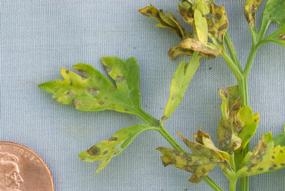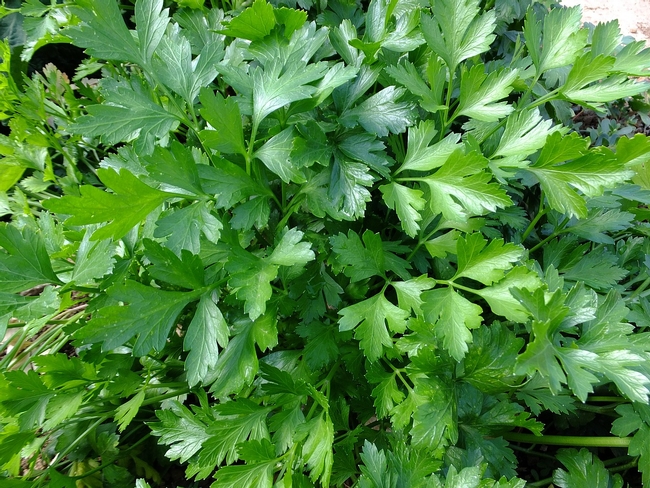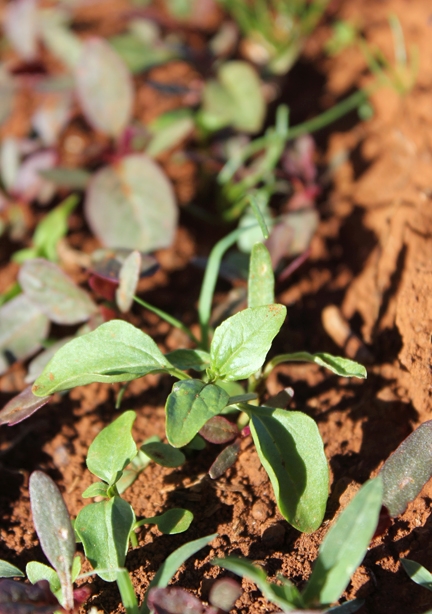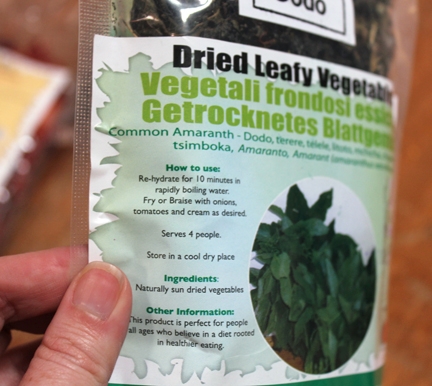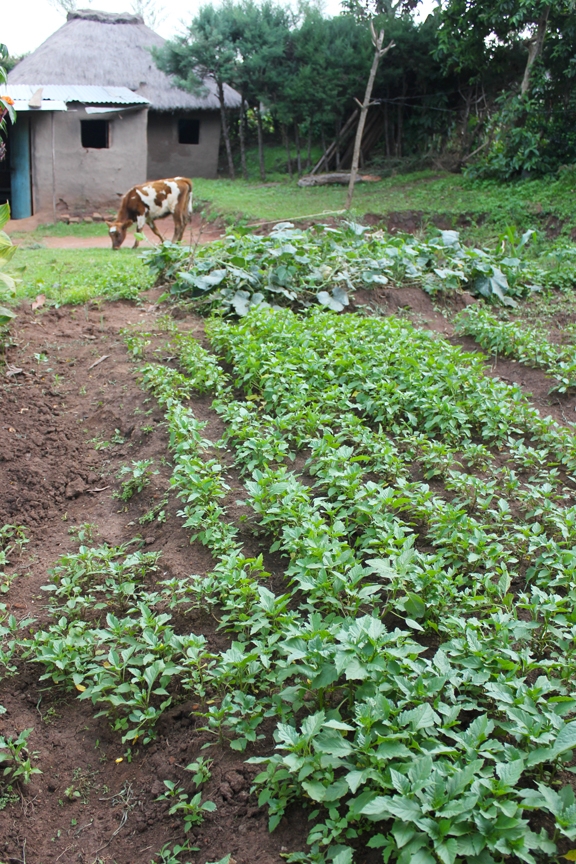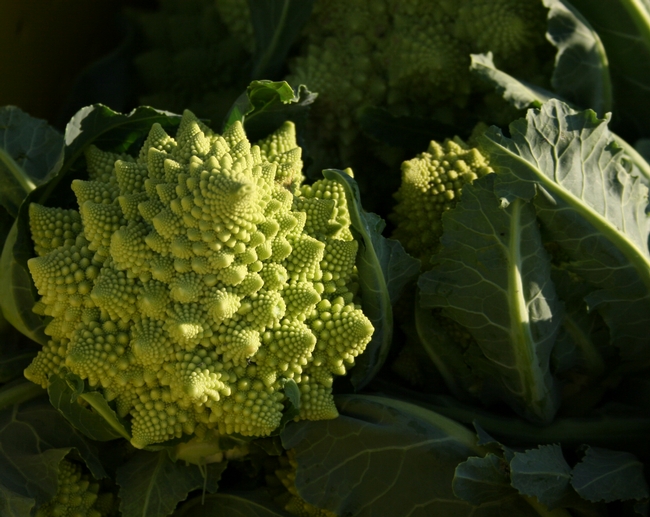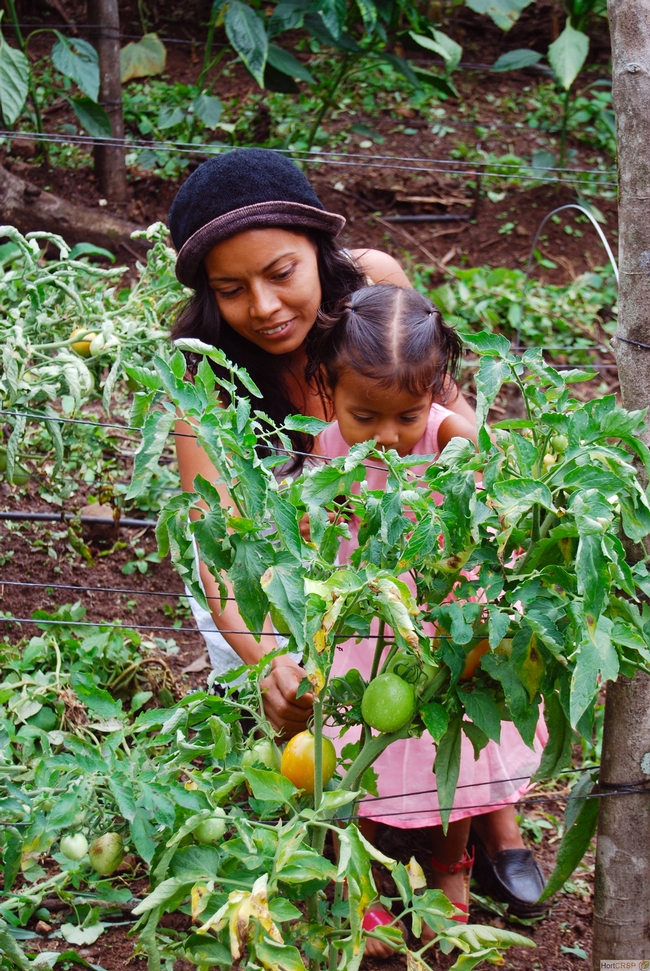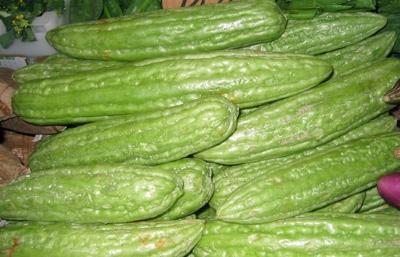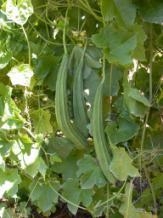Posts Tagged: specialty crops
Protecting California’s parsley crop
When most people think about parsley, they likely think of it as an inedible garnish a chef places on their plate. But parsley is widely used in dried spice mixes, soups and other prepared foods as well as in salads and other recipes. Currently, California produces almost 2,600 acres of parsley at a value of $18 million a year, with Monterey and Ventura counties accounting for 49 percent of the state's parsley production.
California parsley is produced typically in high volumes and with high quality. However in the past few years, growers began to observe unfamiliar disease issues in their parsley fields. Leaf spots, blighted foliage and yellowed plants contributed to loss of quality and reduced yields. Steven Koike and Oleg Daugovish, UC Cooperative Extension advisors in Monterey and Ventura counties respectively, stepped in to investigate the new parsley problems. They collaborated with farmers and pest control advisers to understand the extent of the problems and to obtain samples of the diseased crops.
The UC Cooperative Extension plant pathology diagnostic lab in Salinas was successful in isolating and identifying several pathogens that were responsible for causing the disease symptoms. Working with USDA, they found that three new diseases were present in California parsley crops: bacterial leaf spot, Stemphylium leaf spot, and Apium virus Y disease.
Two of these problems are seedborne, so future management will include the use of pathogen-free seeds. The Apium virus Y pathogen is found in weeds, so growers will need to remove poison hemlock, among others.
Previous to this research, some growers were spraying symptomatic fields because they believed that a disease called late blight was responsible for the disease symptoms. Growers have now ceased making these sprays, eliminating the use of unnecessary chemicals and saving costs.
Click here for more on this research.
When weeds make good eats
Last week, NPR offered up a novel weed control solution for all those yellow dandelions dotting your lawn: just eat 'em. The article includes a chef's recipe for dandelion flower fritters.
The idea that weeds can be edible pops up periodically, with articles suggesting one person's weeds are another person's salad bar, highlighting chefs who “have a way with weeds,” discussing ways medieval gardeners encouraged weeds, and even suggesting ways to eat away at invasive species. But is this something we should take seriously?
“We call these plants weeds because of the way we interact with them. They're in our gardens, they're in our lawns, and they're competing with plants that we prefer to eat,” said Lynn Sosnoskie, a weed scientist at UC Davis. “But a lot of the plants that are weeds here in the United States were brought here purposefully—to be eaten.”
Sosnoskie's doctoral thesis was on just such a plant, with the tasty name of “garlic mustard.” She has also worked at length on Palmer amaranth, a pernicious weed found in cotton fields that can be glyphosate-resistant. In response to one Georgia farmer asking in exasperation if he should just eat the plant taking over his fields, she did some preliminary research into eating Palmer amaranth.
“It's probably not feasible to eat our way out of a serious weed problem,” she said. “But I certainly feel like we can investigate them as other potential food sources.”
In fact, the Horticulture Innovation Lab at UC Davis has a project that is researching three “indigenous vegetables” in Africa, two of which — amaranth and black nightshade — are considered weeds in the United States. The vegetables can be nutritious and profitable options for small-scale farmers in Kenya, Tanzania, Zambia and elsewhere.
“I think some of these weeds have a lot of potential and are underutilized,” said Stephen Weller, horticulture professor at Purdue University, who leads the indigenous vegetables project. “In eastern Africa, these vegetables are very popular. And I really think that as we get more immigrants here from that region, there is going to be a market for some of these vegetables here.”
Though he holds a Ph.D. in weed science, Weller is now figuring out the best ways to cultivate amaranth and black nightshade — instead of to eliminate them. Before he started working with these plants, common assumptions held that they should be easy to grow because, well, they “grow like weeds.”
“But we found out that growing them is more intensive than we were initially led to believe — similar to growing any other vegetable,” Weller said. “They need water, they need fertilizer, and pests are a problem.”
Caveat emptor: Though weedy plants can indeed be a source of food, both scientists cautioned against thinking of weeds as a “free-for-all forage buffet.” Some plants may be toxic, and weeds in farm fields may have been sprayed recently. It is important to be knowledgeable of the plants and how they've been grown before trying to eat one.
Why growing fruits and vegetables matters
From broccoli to watermelon, California farmers grow more than 400 agricultural commodities. In 2011, California was the primary producer of almonds, artichokes, dates, figs, raisins, kiwi, olives, cling peaches, pistachios, dried plums, pomegranates and walnuts— accounting for nearly 100 percent of each of these crops grown in the United States.
When Americans think of “agriculture,” California may not be the first state to come to mind. But the Golden State — just this one state — produced nearly half of all fruits, nuts and vegetables grown in the U.S. in 2011 (source).
In this land of abundance, UC Agriculture and Natural Resources is asking researchers and the general public to discuss, “How do we sustainably feed 8 billion people by 2025?” at the Global Food Systems Forum, April 9. National and international panelists will share insights along the local-global continuum of “California Roots, Global Reach.”
What can Californians add to this conversation that hasn’t already been said? What are we uniquely positioned to address or to share? May I suggest: fruits and vegetables.
Of course, I’m not the first one to suggest this.
According to the Global Horticulture Assessment*, published by UC Davis with input from stakeholders around the world:
“Horticultural crops play a valuable role in food systems by diversifying diets and fostering increased dietary consumption of micronutrients and other plant products known to benefit human health (fiber, antioxidants, etc.).
"Changes in production systems over the past 40 years favor an increase in cereal-based diets. The emphasis on staples has resulted in reduced dietary diversity and the displacement of traditional crops that were important sources of micronutrients such as iron, vitamin A, B-12 and zinc.”
A lack of dietary diversity can signify a serious issue in developing countries where daily eating patterns are centered on starchy staple foods — with very few fruits, vegetables or animal-based products. Reduced dietary diversity can point to micronutrient deficiencies, which could be addressed through fruit and vegetable consumption.
Growing fruits and vegetables — to be eaten and sold — has the potential to improve diets while also boosting incomes.
What do you think? Why do fruits and vegetables matter? What can Californians contribute to the questions of global food security? Join the conversation now by following #Food2025 on Twitter.
*The "Global Horticulture Assessment" called for the creation of the Horticulture Collaborative Research Support Program, and serves as a guiding document for the program. With funding from USAID, Horticulture CRSP is led by UC Davis and builds international partnerships for fruit and vegetable research that improves livelihoods in developing countries.
UCCE makes Southeast Asian vegetables easy to eat
Most Americans gravitate toward the familiar in supermarket produce aisles. But some creative shopping unveils a tremendous diversity of edible vegetables that can turn an ordinary menu into a much more interesting cuisine.
At certain roadside stands, at farmers markets that cater to diverse clientele and in small Asian supermarkets, adventurous Californians can buy vegetables like bitter melon, Chinese long beans, opo and luffa. Finding them is the first step, knowing how to prepare them is another matter. UC Cooperative Extension has made these less familiar vegetables more accessible by creating a collection of easy-to-cook and nutritious Southeast Asian vegetable recipes.
The recipes were developed by UCCE nutrition educators in Fresno and the statewide UC Expanded Food and Nutrition Education Program team with Richard Molinar, a UCCE advisor in Fresno County. Connie Schneider, director of the UC Youth, Families and Communities Program, and Molinar started by researching the traditional usage of Asian vegetables. They modified some ingredients and procedures in the recipes to simplify preparation and improve the nutritional profile.
“We minimized the number of ingredients in each recipe, added clear measurements and tested the dishes,” Schneider said. “They are delicious.”
For the last 18 years, Molinar has worked with small-scale farmers in Fresno County, which boasts the largest concentration of Hmong farmers in the U.S. Fresno County is also home to farmers of other ethnicities from Laos, China and Vietnam. Molinar and his assistant, Michael Yang, have introduced Southeast Asian immigrant farmers to the latest farming technologies, helped them develop plans to ensure the safety of the food they grow, and worked with them to find new marketing opportunities. Many of these farmers have begun growing vegetables common in California, and most have also kept some space on the farm for the vegetables of their homelands.
The UCCE educators recognized that the rich culinary traditions of local Southeast Asian immigrants could be adapted and used by people of all cultures to increase their consumption of vegetables. Besides, encouraging consumption of Southeast Asian vegetables adds new marketing opportunities for the farmers.
“This has been a unique opportunity to bring UCCE’s farm advisors and nutrition educators together to assist farmers and the public,” Molinar said. “These recipes will encourage more people to buy these nutritious vegetables, expanding the market for the growers.”
The 12 recipes are printed on cards, each with photos of the fresh vegetable and background information. For example, the recipe card for “bitter melon stir fry” notes that the crinkly skinned vegetable is native to India and is eaten when young and green, as bitterness increases with age. The recipe is accompanied by a photo of the prepared dish and complete nutrition facts per serving.
Most people are familiar with luffa after it has dried into a natural scrubby. It is often found near beauty products in stores and purchased to exfoliate the skin. However, the UCCE recipe card for “luffa and prawns” notes that fresh green luffa has a similar but sweeter flavor than zucchini summer squash when stir fried. Either the smooth or angled varieties of luffa can be used in the recipe.
"I grew up with zucchini," Molinar said, "but I prefer the flavor and texture of angled luffa."
The printed cards will be distributed at farmers markets where Southeast Asian vegetables are sold, and they are available on the Fresno County UC Cooperative Extension website. Farmers who sell Asian vegetables at farmers markets may pick up 10 packets of recipes for free at the UC Cooperative Extension in Fresno, 1720 S. Maple Ave., Fresno. Direct links to each of the recipes are below:
- Bitter Melon Stir Fry
- Chinese Long Bean and Tofu Salad
- Chinese Winter Melon Chicken Soup
- Field of Greens Salad
- Fuzzy Gourd Stuffed with Pork and Mushrooms
- Lemongrass Chicken Soup
- Luffa and Prawns
- Marinated Japanese Eggplant
- Opo and Beef
- Snow Pea Daikon Salad
- Strawberry Spring Rolls
- Spicy Shrimp and Bok Choy Noodle Bowl
Following are two sample recipes:
Bitter Melon Sir Fry
Serves 4
Ingredients:
1 ripe bitter melon, seeded and sliced
1 tablespoon olive oil
1 onion, diced
3 garlic cloves, crushed
½ lb. ground pork
½ lb. medium shrimp, peeled and deveined
1 tomato, chopped
1 tablespoon reduced sodium soy sauce
Pepper to taste
Directions:
- Place sliced bitter melon in boiling water until just tender (2-3 minutes). Drain
- Heat olive oil in skillet over medium heat. Sauté onions for about 5 minutes until tender.
- Add garlic; sauté an additional 2 minutes; mix in pork and cook until no longer pink.
- Add shrimp; cook about 5 minutes until done.
- Add tomato, bitter melon, and soy sauce; cook until tender.
Luffa and Prawns
Serves 4
Ingredients:
1 tablespoon vegetable oil
1 garlic clove, minced
1 lb large prawns, peeled and deveined
2 luffa (angled luffa or smooth luffa), chopped
¼ cup bamboo shoots
1 teaspoon coriander
1 tablespoon reduced sodium soy sauce
1 green onion, sliced
Directions:
- Heat oil in a wok/pan; add garlic and stir fry for 1 minute.
- Add prawns; cook until done
- Add luffa; continue to stir fry with prawns until just tender, about 5 minutes.
- Add bamboo shoots, coriander, and soy sauce to pan and stir fry a few minutes
- Sprinkle with green onion and serve.
Fairground farms & farmyard festivals
Do county fairs make you think of deep-fried Twinkies and Ferris wheels, and maybe some prize-winning pigs? Can you imagine a local food marketplace next to the quilt show, a demonstration farm by the pony rides, fresh fruit for sale in the midway, a community dinner honoring local farmers, and housing available for hundreds of farm-workers the week after the fair closes?
These all thrive at some of California's county and district fairs, and may be part of the future at many others soon. The University of California small farm program and the California Department of Food and Agriculture (CDFA) Division of Fairs and Expositions are teaming up to connect fruit, vegetable, nut and flower farmers with county and regional fairs to celebrate California specialty crops and encourage agritourism. Fair organizers also hope to develop new partnerships that help support the fairs - particularly important now as the fairs have recently lost funding due to state budget cuts.
“We look forward to working with CDFA’s Division of Fairs and Expositions to expand agritourism opportunities; this will expand revenue sources for California’s small farmers,” said Shermain Hardesty, UC Cooperative Extension specialist in the UC Davis Department of Agricultural and Resource Economics. Hardesty leads the UC small farm program.
Together we are organizing workshops and tours for farmers and agricultural leaders at seven different fairs throughout the state, to be held during fair time in the 2012 fair season. We're calling the project "Fairground Farms and Farmyard Festivals; Showcasing California Specialty Crops."
Each workshop will be a little different, because each of the fairs has it's own unique history and community. We'll hear fair officials sharing with farmers some of their methods for safely entertaining and feeding thousands of people. We'll have presentations by farmers currently involved with local fairs or local agritourism, interactive discussions on potential collaborations between specialty crop growers, agritourism operators and fairs, and guided tours of the fair facilities.
At the first workshop, held at the Shasta District Fair in Anderson on June 14, fair leaders from several Northern California fairs listened to Tehama County Farm Bureau leader Kari Dodd explain how she had helped set up the marketplace for local growers at the Tehama County Fair. Then they discussed how to set such a program up at their own fairs. Other ideas raised by the group included demonstration farms and gardens, greenhouses, year-round restaurants and rental kitchens at the fair grounds, and local food events.
The next workshop and tour will be Thursday July 26 at the Amador County Fair in Plymouth, hosted by Fair CEO Troy Bowers. At this event we will hear from Mountain Mandarin Festival organizer and cookbook author Joanne Neft, as well as from representatives of Farms of Amador, Amador County Grape Growers, and MotherLode Harvest, who all participate in the Amador Fair. Following Amador, we visit Ventura, Napa, Yolo, Santa Cruz and Fresno.
Registration for all of the workshops is now open. We welcome farmers and fair leaders from surrounding counties to each fair workshop, as well as county agricultural commissioners, Farm Bureau leaders, tourism professionals, farm advisors and educators, fair and festival vendors and entertainers and agritourism operators interested in new partnerships.
Let's talk!
The workshop schedule:
Thursday, July 26 - Amador County Fair, Plymouth
Thursday, August 2 - Ventura County Fair, Ventura
Thursday, August 9 - Napa Town & Country Fair, Napa
Thursday, August 16 - Yolo County Fair, Woodland
Thursday, September 13 - Santa Cruz County Fair, Watsonville
Thursday, October 4 - Big Fresno Fair, Fresno
For registration and more information about the events is online or call Penny Leff at (530) 752-7779
See you at the fair!


